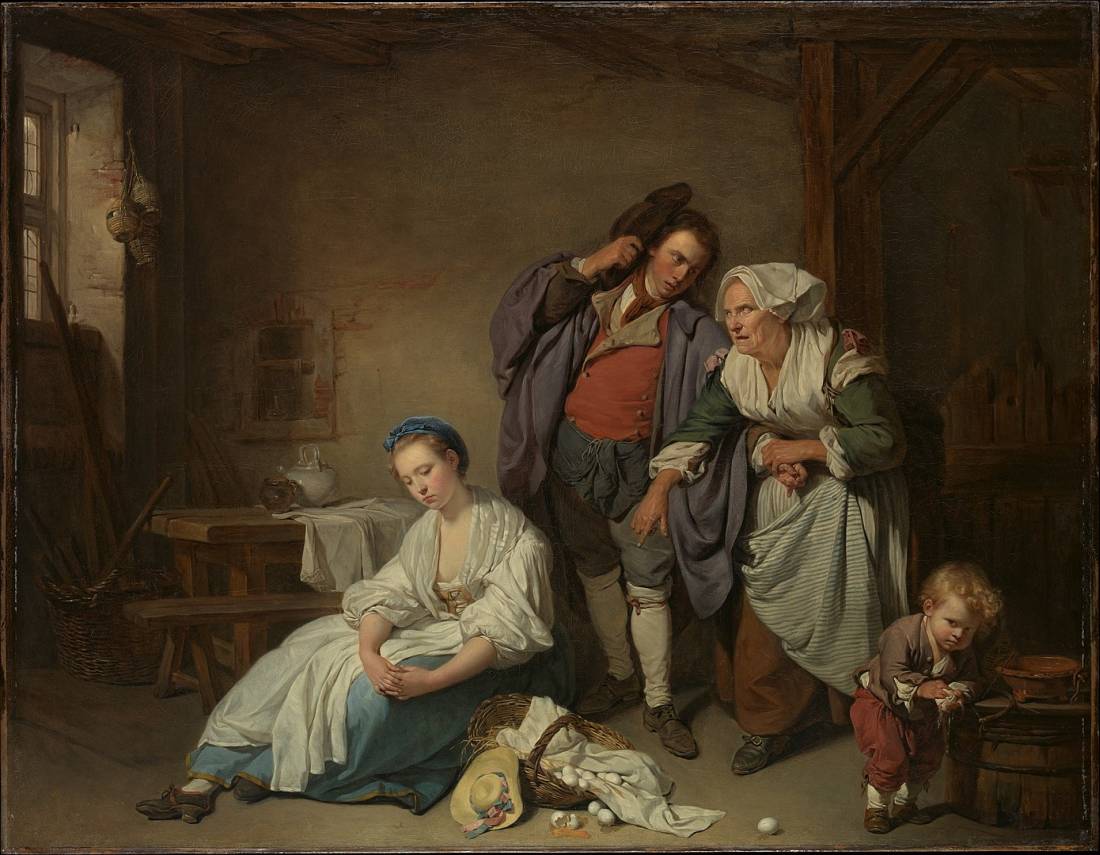
Jean-Baptiste Greuze: The Master of Sentimental Genre Painting
Jean-Baptiste Greuze (1725–1805) was one of the most admired French painters of the eighteenth century, known for his emotionally charged genre scenes, polished technique, and deep understanding of human expression. His work bridges the gap between the decorative elegance of the Rococo and the emerging moral seriousness of Neoclassicism. Today, Greuze’s paintings continue to attract art historians, collectors, and museums for their tender domestic subjects, subtle lighting, and refined brushwork.
This article provides a complete exploration of Jean-Baptiste Greuze’s life, his most famous artworks, and the lasting art value of his paintings. We’ll also examine why his sentimental scenes of family life continue to captivate both decorative and fine art collectors worldwide.
Early Life and Artistic Training
Jean-Baptiste Greuze was born in 1725 in Tournus, a small town in Burgundy, France. His father was a roofer, and like many provincial artists of the period, Greuze’s talent was recognized early. He began his formal training under Charles Grandon in Lyon before moving to Paris, the artistic center of Europe in the mid-eighteenth century.
In Paris, Greuze studied at the Académie Royale de Peinture et de Sculpture, where he absorbed the techniques of great masters such as Jean-Baptiste-Siméon Chardin and François Boucher. However, unlike Boucher’s playful Rococo fantasies, Greuze was drawn to more moralistic and sentimental subjects , depictions of ordinary people caught in tender domestic moments.
By the 1750s, Greuze’s works began to appear in the Salon exhibitions, where they were praised for their emotional realism and moral depth. His rise to fame was swift, and his reputation as a painter of domestic virtue was firmly established by the 1760s.
The Rise of Sentimental Genre Painting
Before Greuze, French painting in the eighteenth century was dominated by Rococo themes , mythological nymphs, aristocratic leisure, and decorative elegance. Greuze shifted the focus dramatically. Instead of showing gods and goddesses, he painted ordinary families, young lovers, and dutiful children, portraying virtue and morality in daily life.
This new approach resonated with the Enlightenment ideals of Jean-Jacques Rousseau, who promoted simplicity, natural emotion, and moral sincerity. Greuze’s paintings embodied these ideas visually, turning private emotions into public art.
His scenes , often small in scale and rich in detail , invite the viewer into intimate domestic spaces filled with warmth and compassion. Through expressions, gestures, and carefully balanced compositions, Greuze told stories of love, duty, and remorse that could move audiences to tears.
As critic Denis Diderot famously wrote after seeing Greuze’s paintings at the Salon:
“Greuze is a moralist in painting, a man who teaches virtue with his brush.”
Jean-Baptiste Greuze’s Most Famous Artwork: The Village Bride
Among Greuze’s many celebrated works, “The Village Bride” (La Mariée de Village), painted in 1761, stands as his most famous and influential painting.
The Story and Composition
The Village Bride depicts the emotional moment when a young bride, surrounded by her family, receives her dowry and blessings before her marriage. Unlike the grand mythological weddings seen in earlier art, this scene unfolds in a modest peasant home. The father’s gesture of handing over the dowry symbolizes both love and loss , a universal expression of parental emotion.
The painting’s gentle lighting, warm color palette, and balanced composition create an atmosphere of calm sincerity. Every figure in the scene plays a role: the bride, shy and radiant; the groom, respectful and earnest; the father, proud yet wistful; and the family members, whose faces reflect the complexity of parting and joy.
Emotional Realism and Symbolism
Greuze’s genius lay in his ability to convey emotional authenticity without theatrical exaggeration. The soft lighting highlights the faces and hands, drawing attention to the gestures of affection and tenderness. The carefully arranged domestic setting , a table, a simple home interior, rustic furnishings , reinforces the painting’s moral message: happiness and virtue are found in honest family life, not wealth or social status.
When The Village Bride was exhibited at the 1761 Salon, it was an immediate success. Critics and the public alike praised its sincerity, and Diderot declared it “the triumph of moral painting.” The work also inspired playwrights, writers, and other artists, establishing Greuze as the leading figure in sentimental genre painting.
Other Notable Works by Jean-Baptiste Greuze
Although The Village Bride is Greuze’s signature masterpiece, his career produced numerous other paintings that reveal the same attention to emotion, light, and moral storytelling. Some of his best-known works include:
1. The Broken Jug (La Cruche Cassée), c. 1771
This delicate and slightly mischievous painting shows a young girl holding a broken jug , a traditional symbol of lost innocence. The girl’s innocent expression contrasts with the subtle symbolism, inviting viewers to read multiple layers of meaning. The smooth texture of her skin, the luminous drapery, and the refined brushwork exemplify Greuze’s technical mastery.
2. The Father’s Curse and The Punished Son, 1777–1778
This pair of paintings tells a moralizing story in two acts. The first depicts a young man leaving home against his father’s wishes; the second shows his tragic return, wounded and repentant. The series echoes the didactic tone of moral drama and emphasizes Greuze’s ability to blend narrative intensity with visual grace.
3. The Milkmaid, c. 1760
In this charming painting, a country girl carries a jug of milk with simplicity and grace. The subject may appear light, but Greuze’s treatment elevates her humble task into a symbol of purity and natural beauty , ideals central to the Enlightenment and sentimental art.
4. A Girl with a Dead Canary, c. 1765
This emotionally charged scene captures a young woman mourning her pet bird. The subtle play of grief and innocence makes this work one of Greuze’s most moving character studies, showcasing his gift for portraying delicate human emotion.
Style and Technique: Light, Texture, and Sentiment
Jean-Baptiste Greuze’s artistic style blends the technical precision of the Old Masters with the emotional sensitivity of modern portraiture. His approach was characterized by:
1. Subtle Lighting
Greuze’s mastery of light allows him to model soft textures , skin, fabric, and hair , with remarkable delicacy. His use of diffused, gentle illumination gives his scenes a warm, intimate quality, emphasizing tenderness rather than drama.
2. Polished Brushwork
Each surface in Greuze’s paintings is rendered with careful attention. His smooth, polished technique enhances the sense of refinement and contributes to the decorative appeal that attracts collectors today.
3. Emotional Expression
Unlike the theatrical gestures of Baroque art, Greuze’s figures express emotion through nuanced glances, gestures, and postures. A father’s sigh, a daughter’s tear, or a lover’s shy look communicates entire narratives of feeling.
4. Moral Storytelling
Every element in a Greuze painting serves a moral or sentimental purpose. His subjects were not chosen for grandeur, but for their ability to reveal human goodness, virtue, or repentance. In this way, Greuze turned everyday life into a stage for ethical reflection.
The Decline and Rediscovery of Greuze
During the late 1770s and 1780s, Greuze’s popularity began to wane. As Neoclassicism rose under artists like Jacques-Louis David, moral sentiment gave way to heroic idealism and historical grandeur. Greuze continued to paint domestic subjects, but critics began to see his work as sentimental or outdated.
After the French Revolution, Greuze’s fortunes declined further. Many of his patrons , members of the aristocracy , lost their wealth or lives, and the art world shifted toward new aesthetic ideals. Greuze died in 1805, nearly forgotten by the public that had once adored him.
Yet, by the nineteenth century, Greuze’s work was rediscovered. Collectors and museum curators recognized his paintings as important documents of Enlightenment-era emotion and bourgeois morality. Today, his works are housed in major institutions such as the Louvre, the Hermitage Museum, and the National Gallery in London.
Market Value
Greuze’s paintings and drawings remain valuable in the art market. While prices vary depending on subject, condition, and provenance, major works have sold at auction for hundreds of thousands to several million dollars. His sketches and portraits, often featuring expressive young women, are particularly prized for their charm and intimacy.
The paintings of Jean-Baptiste Greuze hold significant value in today’s art market, admired by both fine art collectors and decorative art enthusiasts. As one of the most celebrated eighteenth-century French painters, Greuze’s works are prized for their refined technique, emotional storytelling, and historical importance.
The value of a Jean-Baptiste Greuze painting can vary greatly depending on its subject, size, condition, and provenance. Smaller oil sketches, studies, or portraits may sell for $20,000 to $80,000 USD, while more elaborate finished compositions , especially those featuring his signature sentimental family scenes , can reach hundreds of thousands or even millions.
Major works by Greuze that have appeared at auction have achieved impressive results. For example, Head of a Young Girl sold at Christie’s for over $1 million, and The Guitar Player brought nearly $2 million in a Sotheby’s sale. His most refined and well-documented canvases, such as variations on The Village Bride or The Broken Jug, are considered museum-quality and can command multi-million-dollar prices when they appear on the market , though such masterpieces are increasingly rare.
Drawings, often studies for larger paintings, also have strong demand. These delicate works on paper, highlighting Greuze’s mastery of expression and line, typically range between $10,000 and $100,000, depending on detail and provenance.
Jean-Baptiste Greuze’s Legacy
Greuze’s influence extended far beyond his lifetime. His sentimental storytelling inspired artists across Europe, from Italian and German painters to English genre specialists like Sir David Wilkie and George Morland.
In literature, his imagery resonated with writers of the Romantic and Victorian eras, who shared his fascination with family emotion and moral virtue. Even modern filmmakers and photographers have drawn inspiration from his use of light and expression.
Today, art historians view Greuze as a pivotal figure who captured the emotional atmosphere of his age , the yearning for sincerity in a world of elegance and artifice.
Where to See Greuze’s Paintings
For art lovers wishing to experience Jean-Baptiste Greuze’s genius firsthand, several museums hold major examples of his work:
The Louvre Museum (Paris): Home to The Village Bride, The Broken Jug, and several portraits.
The Hermitage Museum (St. Petersburg): Holds The Father’s Curse and The Punished Son.
The National Gallery (London): Displays A Girl with a Dead Canary.
The Metropolitan Museum of Art (New York): Houses Greuze’s intimate portraits and sketches.
Seeing these works in person reveals the subtle textures, quiet emotion, and masterful composition that reproductions can only suggest.
Why Jean-Baptiste Greuze Still Matters Today
In an age of digital distraction, Greuze’s paintings remind us of the value of sincerity, family connection, and emotional authenticity. His art invites viewers to slow down and reflect on the tender moments that define human life , a parent’s pride, a child’s innocence, a lover’s shyness, or a moment of forgiveness.
Collectors value Greuze for these same reasons: his works combine beauty, craftsmanship, and heartfelt storytelling. Whether displayed in museums or private collections, they continue to speak to universal human feelings with a voice as clear today as it was 250 years ago.
Jean-Baptiste Greuze stands as one of the great interpreters of emotion in eighteenth-century art. His sentimental genre scenes, rendered with subtle lighting and polished brushwork, transformed everyday domestic life into moral poetry.
From The Village Bride to The Broken Jug, his paintings tell timeless stories of love, virtue, and compassion. Though his reputation faded for a time, modern audiences and collectors have rediscovered his genius, ensuring that his tender vision of humanity endures.
For those seeking art that combines emotional depth, technical mastery, and decorative beauty, the works of Jean-Baptiste Greuze remain an enduring treasure of the French artistic tradition.




